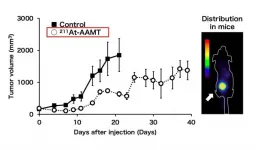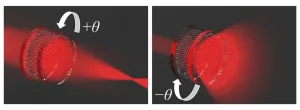(Press-News.org) EUGENE, Ore. -- Jan. 4, 2021 -- Phosphorous, calcium and charcoal in spotty patches of fertile soil in the Amazon rainforest suggest that natural processes such as fires and river flooding, not the ingenuity of indigenous populations, created rare sites suitable for agriculture, according to new research.
The presence of pre-Columbian artifacts and signs of plant domestication uncovered in the region's fertile soil, commonly called Amazonian dark earth, had been thought to mean that agricultural practices, including controlled burning, by indigenous people had boosted soil nutrients.
However, radiocarbon dating of soil at an extensively studied 210-hectare basin near the confluence of the Solimoes and Negro rivers in northwest Brazil tell a different story, said Lucas Silva, a professor of environmental studies at the University of Oregon who led the project.
In a paper that published Jan. 4 in Nature Communications, a 14-member team report that phosphorous and calcium levels at the site, which is home to the Brazilian Agricultural Research Corp., are orders of magnitude higher than in surrounding soil.
Those levels, Silva said, correlate spatially with 16 trace elements that indicate that fertility did not form in place. Combined with other elements in the soil and isotopic ratios of neodymium and strontium, the researchers concluded that pre-settlement river flooding likely delivered nutrients and charcoal from upstream.
"We analyzed carbon and nutrient pools in light of the local anthropological context to estimate the chronology of management and the population density needed to attain the observed gain in Amazonian dark earth fertility compared to the surrounding landscape," Silva said.
Much of the Amazon contains highly weathered oxisols and ultisols, tropical soil types with high acidity and low nutrient levels. Archaeological artifacts have been found in charcoal-rich soil that began forming about 7,600 years ago, about 1,000 years before indigenous people transitioned from nomadic to sedentary populations in patches of land in the notoriously nutrient-poor Amazon environment, the researchers noted.
"Our results show that large sedentary populations would have had to manage soils thousands of years prior to the emergence of agriculture in the region or, more likely, that indigenous peoples used their knowledge to identify and preferentially settle areas of exceptionally high fertility before the onset of soil management in central Amazonia," he said.
Researchers have long theorized that Amazonian dark earth had been formed by controlled burning of forest biomass. That view, Silva said, fueled an entire industry of charcoal production from biosolids, such as biochar, in which such soils are considered a model for sustainable agriculture.
Charcoal and nutrient accumulation, the researchers argue, match that found in sedimentary deposits that can be traced to open vegetation fires upstream from rivers that flooded.
Records of soil content and past monsoon intensity, the researchers said, indicate a climate-driven shift in river dynamics after a long dry period between 8,000 and 4,000 years ago. That shift to flooding, they noted, would have reduced fire disturbance, increased regional tree coverage and "could have caused divergent patterns of carbon and nutrient accumulation in flooded versus non-flooded areas," consistent with the minerals in the dark earth at the research site.
Many areas of central Amazonia today are associated with sediment deposits that reflect flood regimes that were either deactivated during the Holocene or are presently in the process of deactivation, when sedimentary deposits become suitable habitats for grasslands within the rainforest, the researchers wrote.
"Our findings underscore the need for a broader view of landscape evolution as a path towards understanding the formation of Amazonian dark earths and redirecting applications for sustainable land use and conservation," said Silva, who has visited and gathered samples from the site since 2009 when he was a doctoral student.
"If corroborated elsewhere," he said, "our hypothesis would transform our understanding of human influence in Amazonia, opening new frontiers for the sustainable use of tropical landscapes going forward."
INFORMATION:
In addition to Silva, the study's UO co-authors were Daniel Gavin, a professor of geography, UO doctoral student Jamie L. Wright and Barbara Bomfim, a former postdoctoral researcher in Silva's lab now at the Lawrence Berkeley National Laboratory, and Lauren Hendricks, a doctoral student in Gavin's lab.
Other co-authors are at the University of Brasilia, University of Parano in Brazil, Brazilian Agricultural Research Corp. in Embrapa, Federal Institute of Southeast Minas Gerais in Brazil and University of Nottingham in the United Kingdom.
The National Science Foundation and a seed grant from the University of Oregon's Office of Research and Innovation supported the work by Silva's group in the study.
Links:
Paper in Nature Communications: https://doi.org/10.1038/s41467-020-20184-2
Silva's Soil Plant Atmosphere Research Lab: https://soilplantatmosphere.com/
UO Environmental Studies Program: https://envs.uoregon.edu/
Related work by Silva in the Amazon: https://around.uoregon.edu/content/uo-led-project-maps-human-climate-impacts-amazon
What The Study Did: Denmark was one of the first countries to enforce lockdown to reduce the spread of COVID-19 and subsequent gradual reopening, whereas Sweden has had few restrictions, largely limited to public recommendations. Researchers assessed public mobility and social media attention associated with COVID-19 spread and societal interventions from February to June in Denmark and Sweden.
Authors: Isabell Brikell, Ph.D., of the Karolinska Institutet in Stockholm, is the corresponding author.
To access the embargoed study: Visit our For The Media website at ...
What The Study Did: Researchers used health insurance data from Taiwan to investigate the risk of substance use disorder among patients with autism spectrum disorder and its associations with risk of death.
Authors: Chih-Sung Liang, M.D., of the National Defense Medical Center, and Mu-Hong Chen, M.D., Ph.D., of the Taipei Veterans General Hospital in Taipei, Taiwan, are the corresponding authors.
To access the embargoed study: Visit our For The Media website at this link https://media.jamanetwork.com/
(doi:10.1001/jamapediatrics.2020.5371)
Editor's Note: The article includes funding/support disclosures. Please see the article for additional information, including other authors, author ...
Bitterling fishes (Subfamily: Acheilognathinae) spawn in the gills of living freshwater mussels obligately depending on the mussels for reproduction. On the Matsuyama Plain, Japan, populations of unionid mussels--Pronodularia japanensis, Nodularia douglasiae, and Sinanodonta lauta--have decreased rapidly over the past 30 years. Simultaneously, the population of a native bitterling fish, Tanakia lanceolata, which depends on the three unionids as a breeding substrate, has decreased. Furthermore, a congeneric bitterling, Tanakia limbata, has been artificially introduced, and hybridisation and genetic introgression occur between them. Here, we surveyed the reproduction and occurrence of hybridisation between native and invasive species ...
Improving solar cell design is integral for improving energy consumption. Scientists have lately focused on making solar cells more efficient, flexible, and portable to enable their integration into everyday applications. Consequently, novel lightweight and flexible thin film solar cells have been developed. It is, however, not easy to combine efficiency with flexibility. For a material (usually a semiconductor) to be efficient, it must have a small "band gap"--the energy required to excite charge carriers for electrical conduction--and should absorb and convert a large portion of the sunlight into electricity. Till date, no such efficient absorber suitable for thin film solar cells has been developed.
Typically, charge carriers in a semiconductor are ...
Osaka, Japan - A cancer-specific L-type amino acid transporter 1 (LAT1) is highly expressed in cancer tissues. Inhibiting the function of LAT1 has been known to have anti-tumor effects, but there has been limited progress in the development of radionuclide therapy agents targeting LAT1. Now, a multidisciplinary research team at Osaka University has established a targeted alpha-therapy with a novel drug targeting LAT1.
The researchers first produced the alpha-ray emitter 211Astatine, no easy task given that Astatine (At) is the rarest naturally occurring element on Earth. Targeted alpha-therapy selectively delivers α-emitters to tumors; the advantage over conventional β-therapy is that alpha ...
The odd, wavy pattern that results from viewing certain phone or computer screens through polarized glasses has led researchers to take a step toward thinner, lighter-weight lenses. Called moiré, the pattern is made by laying one material with opaque and translucent parts at an angle over another material of similar contrast.
A team of researchers from Tokyo University of Agriculture and Technology, TUAT, in Japan have demonstrated that moiré metalenses--tiny, patterned lenses composed of artificial "meta" atoms--can tune focal length along a wider range than previously seen. They published their results on November ...
Mothers and fathers of children diagnosed with cancer are affected financially in different ways. While mothers' incomes fall in the short term and then rise, the adverse financial repercussions on fathers occur later. Researchers at Uppsala University have investigated the socioeconomic impact on parents of having a child diagnosed with cancer. The study is published in the International Journal of Cancer.
Previous research has shown that when a child falls ill with cancer, the parents are affected financially as well as psychologically. The available literature shows that mothers are more affected than ...
High-performance, eco-friendly, safe and at the same time cost-effective: the zinc-air battery is an attractive energy storage technology of the future. Until now, the conventional zinc-air battery has struggled with a high chemical instability, parasitic reactions which rooted in the usage of alkaline electrolytes lead to electrochemical irreversibility. Based on an innovative, non-alkaline, aqueous electrolyte, an international research team led by scientist Dr. Wei Sun of MEET Battery Research Center at the University of Muenster has developed a new battery chemistry for the zinc-air battery which overcomes the previous technical obstacles. The scientific team has published the detailed results of their research project, involving ...
December 31, 2020 - Data on COVID-19 transmission among Chicago youth - particularly in the city's extensive network of Catholic schools - supports a strategy for gradual reopening of the city's public school system, according to a report in the Journal of Public Health Management and Practice. The journal is published in the Lippincott portfolio by Wolters Kluwer.
"Data from the nation's largest Catholic school system reveals that implementation of layered mitigation efforts can support the goal of reopening in-person education in a safe but not zero-risk environment," write Marielle Fricchione, MD, and colleagues of the Chicago Department of Public Health (CDPH). Based ...
CORVALLIS, Ore. -- A pair of recent studies from Oregon State University found that Oregon's Medicaid expansion in 2014 has led to increased prenatal care among low-income women, as well as improved health outcomes for newborn babies.
In the three years after the expansion, one study found that Oregon saw an almost 2 percentage point increase in first trimester prenatal care utilization, relative to 18% of the pre-expansion population who lacked any access to prenatal care in the earlier stages of pregnancy.
In the same period, the second study found, Medicaid expansion was associated with a 29% reduction in low birthweight among babies born to women on Medicaid, ...




